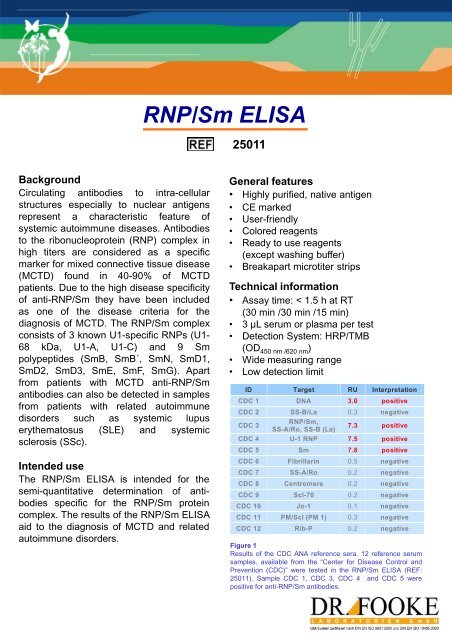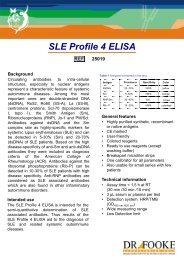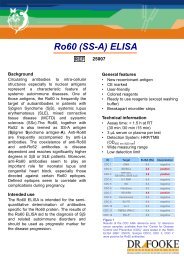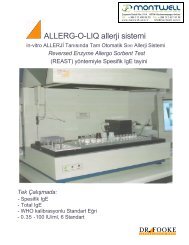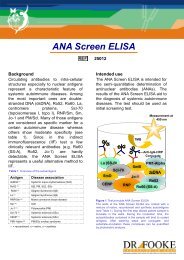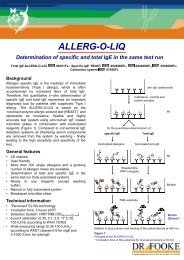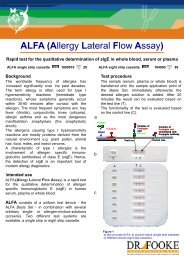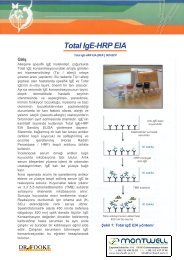RNP/Sm ELISA RNP/Sm ELISA - Montwell.com.tr
RNP/Sm ELISA RNP/Sm ELISA - Montwell.com.tr
RNP/Sm ELISA RNP/Sm ELISA - Montwell.com.tr
You also want an ePaper? Increase the reach of your titles
YUMPU automatically turns print PDFs into web optimized ePapers that Google loves.
<s<strong>tr</strong>ong>RNP</s<strong>tr</strong>ong>/<s<strong>tr</strong>ong>Sm</s<strong>tr</strong>ong> <s<strong>tr</strong>ong>ELISA</s<strong>tr</strong>ong><br />
25011<br />
Background<br />
Circulating antibodies to in<strong>tr</strong>a-cellular<br />
s<strong>tr</strong>uctures especially to nuclear antigens<br />
represent a characteristic feature of<br />
systemic autoimmune diseases. Antibodies<br />
to the ribonucleoprotein (<s<strong>tr</strong>ong>RNP</s<strong>tr</strong>ong>) <s<strong>tr</strong>ong>com</s<strong>tr</strong>ong>plex in<br />
high titers are considered as a specific<br />
marker for mixed connective tissue disease<br />
(MCTD) found in 40-90% of MCTD<br />
patients. Due to the high disease specificity<br />
of anti-<s<strong>tr</strong>ong>RNP</s<strong>tr</strong>ong>/<s<strong>tr</strong>ong>Sm</s<strong>tr</strong>ong> they have been included<br />
as one of the disease criteria for the<br />
diagnosis of MCTD. The <s<strong>tr</strong>ong>RNP</s<strong>tr</strong>ong>/<s<strong>tr</strong>ong>Sm</s<strong>tr</strong>ong> <s<strong>tr</strong>ong>com</s<strong>tr</strong>ong>plex<br />
consists of 3 known U1-specific <s<strong>tr</strong>ong>RNP</s<strong>tr</strong>ong>s (U1-<br />
68 kDa, U1-A, U1-C) and 9 <s<strong>tr</strong>ong>Sm</s<strong>tr</strong>ong><br />
polypeptides (<s<strong>tr</strong>ong>Sm</s<strong>tr</strong>ong>B, <s<strong>tr</strong>ong>Sm</s<strong>tr</strong>ong>B´, <s<strong>tr</strong>ong>Sm</s<strong>tr</strong>ong>N, <s<strong>tr</strong>ong>Sm</s<strong>tr</strong>ong>D1,<br />
<s<strong>tr</strong>ong>Sm</s<strong>tr</strong>ong>D2, <s<strong>tr</strong>ong>Sm</s<strong>tr</strong>ong>D3, <s<strong>tr</strong>ong>Sm</s<strong>tr</strong>ong>E, <s<strong>tr</strong>ong>Sm</s<strong>tr</strong>ong>F, <s<strong>tr</strong>ong>Sm</s<strong>tr</strong>ong>G). Apart<br />
from patients with MCTD anti-<s<strong>tr</strong>ong>RNP</s<strong>tr</strong>ong>/<s<strong>tr</strong>ong>Sm</s<strong>tr</strong>ong><br />
antibodies can also be detected in samples<br />
from patients with related autoimmune<br />
disorders such as systemic lupus<br />
erythematosus (SLE) and systemic<br />
sclerosis (SSc).<br />
Intended use<br />
The <s<strong>tr</strong>ong>RNP</s<strong>tr</strong>ong>/<s<strong>tr</strong>ong>Sm</s<strong>tr</strong>ong> <s<strong>tr</strong>ong>ELISA</s<strong>tr</strong>ong> is intended for the<br />
semi-quantitative determination of antibodies<br />
specific for the <s<strong>tr</strong>ong>RNP</s<strong>tr</strong>ong>/<s<strong>tr</strong>ong>Sm</s<strong>tr</strong>ong> protein<br />
<s<strong>tr</strong>ong>com</s<strong>tr</strong>ong>plex. The results of the <s<strong>tr</strong>ong>RNP</s<strong>tr</strong>ong>/<s<strong>tr</strong>ong>Sm</s<strong>tr</strong>ong> <s<strong>tr</strong>ong>ELISA</s<strong>tr</strong>ong><br />
aid to the diagnosis of MCTD and related<br />
autoimmune disorders.<br />
General features<br />
• Highly purified, native antigen<br />
• CE marked<br />
• User-friendly<br />
• Colored reagents<br />
• Ready to use reagents<br />
(except washing buffer)<br />
• Breakapart microtiter s<strong>tr</strong>ips<br />
Technical information<br />
• Assay time: < 1.5 h at RT<br />
(30 min /30 min /15 min)<br />
• 3 µL serum or plasma per test<br />
• Detection System: HRP/TMB<br />
(OD 450 nm /620 nm )<br />
• Wide measuring range<br />
• Low detection limit<br />
ID Target RU Interpretation<br />
CDC 1 DNA 3.0 positive<br />
CDC 2 SS-B/La 0.3 negative<br />
CDC 3<br />
<s<strong>tr</strong>ong>RNP</s<strong>tr</strong>ong>/<s<strong>tr</strong>ong>Sm</s<strong>tr</strong>ong>,<br />
SS-A/Ro, SS-B (La)<br />
7.3 positive<br />
CDC 4 U-1 <s<strong>tr</strong>ong>RNP</s<strong>tr</strong>ong> 7.5 positive<br />
CDC 5 <s<strong>tr</strong>ong>Sm</s<strong>tr</strong>ong> 7.8 positive<br />
CDC 6 Fibrillarin 0.5 negative<br />
CDC 7 SS-A/Ro 0.2 negative<br />
CDC 8 Cen<strong>tr</strong>omere 0.2 negative<br />
CDC 9 Scl-70 0.2 negative<br />
CDC 10 Jo-1 0.1 negative<br />
CDC 11 PM/Scl (PM 1) 0.3 negative<br />
CDC 12 Rib-P 0.2 negative<br />
Figure 1<br />
Results of the CDC ANA reference sera. 12 reference serum<br />
samples, available from the “Center for Disease Con<strong>tr</strong>ol and<br />
Prevention (CDC)” were tested in the <s<strong>tr</strong>ong>RNP</s<strong>tr</strong>ong>/<s<strong>tr</strong>ong>Sm</s<strong>tr</strong>ong> <s<strong>tr</strong>ong>ELISA</s<strong>tr</strong>ong> (REF:<br />
25011). Sample CDC 1, CDC 3, CDC 4 and CDC 5 were<br />
positive for anti-<s<strong>tr</strong>ong>RNP</s<strong>tr</strong>ong>/<s<strong>tr</strong>ong>Sm</s<strong>tr</strong>ong> antibodies.
Assay performance<br />
• Good correlation to reference <s<strong>tr</strong>ong>ELISA</s<strong>tr</strong>ong><br />
systems<br />
• Excellent “lot to lot” correlation R 2 > 0.95<br />
• Low in<strong>tr</strong>a- and inter-assay variation<br />
CV% < 10<br />
• Excellent linearity over the entire range<br />
No. of <s<strong>tr</strong>ong>com</s<strong>tr</strong>ong>petitiors with<br />
ID Diagnose RU Interpretation positive results for<br />
<s<strong>tr</strong>ong>RNP</s<strong>tr</strong>ong>/<s<strong>tr</strong>ong>Sm</s<strong>tr</strong>ong><br />
AMLI 1 HD 0.2 negative 0<br />
AMLI 2 SLE 6.8 positive 21/21<br />
AMLI 3 MCTD 1.9 positive 20/21<br />
AMLI 4 SjS 0.2 negative 0<br />
AMLI 5 SjS 0.2 negative 0<br />
AMLI 6 Scl 0.2 negative 0<br />
AMLI 7 PM 0.2 negative 0<br />
AMLI 8 CREST 0.2 negative 0<br />
AMLI 9 SLE 0.4 negative 0<br />
AMLI 10 HD 0.2 negative 0<br />
HD = healthy donor; SLE = systemic lupus erythematosus; MCTD =<br />
mixed connective tissue disease; SjS = Sjögren Syndrome; Scl =<br />
systemic sclerosis; CREST = (calcinosis, Raynaud phenomenon,<br />
esophageal dysmotility, sclerodactyly and telangiectasia); PM =<br />
Polymoysitis<br />
Figure 2<br />
Results of the AMLI reference sera. 10 reference serum<br />
samples, available from the Association of Medical Laboratory<br />
Immunologists (AMLI) were tested in the <s<strong>tr</strong>ong>RNP</s<strong>tr</strong>ong>/<s<strong>tr</strong>ong>Sm</s<strong>tr</strong>ong> <s<strong>tr</strong>ong>ELISA</s<strong>tr</strong>ong> (REF:<br />
25011). Samples AMLI 2 and AMLI 3 tested positive in<br />
concordance to the findings of 21 reference laboratories.<br />
Table 1 Prevalence of anti-<s<strong>tr</strong>ong>RNP</s<strong>tr</strong>ong>/<s<strong>tr</strong>ong>Sm</s<strong>tr</strong>ong> in different disease groups<br />
and healthy donors according to the literature<br />
Disease<br />
% pos<br />
literature<br />
% pos<br />
<s<strong>tr</strong>ong>RNP</s<strong>tr</strong>ong>/<s<strong>tr</strong>ong>Sm</s<strong>tr</strong>ong> E LIS A<br />
(REF: 25011)<br />
Reference<br />
<s<strong>tr</strong>ong>RNP</s<strong>tr</strong>ong>/<s<strong>tr</strong>ong>Sm</s<strong>tr</strong>ong> <s<strong>tr</strong>ong>ELISA</s<strong>tr</strong>ong> (2501 1)<br />
neg<br />
pos<br />
neg 0 0 0<br />
pos 3* 62 65<br />
3 62 65<br />
Figure 3<br />
Agreement to reference method. 65 serum samples from<br />
patients with connective tissue disease tested in the <s<strong>tr</strong>ong>RNP</s<strong>tr</strong>ong>/<s<strong>tr</strong>ong>Sm</s<strong>tr</strong>ong><br />
<s<strong>tr</strong>ong>ELISA</s<strong>tr</strong>ong> (REF: 25011) and in a validated reference <s<strong>tr</strong>ong>ELISA</s<strong>tr</strong>ong><br />
demons<strong>tr</strong>ated a good agreement (96.0%) between the two<br />
assays.<br />
*One sample was borderline by <s<strong>tr</strong>ong>RNP</s<strong>tr</strong>ong>/<s<strong>tr</strong>ong>Sm</s<strong>tr</strong>ong> <s<strong>tr</strong>ong>ELISA</s<strong>tr</strong>ong> (RU=1.0)<br />
Literature<br />
1. Tan EM: Antinuclear antibodies: diagnostic<br />
markers for autoimmune diseases and probes for<br />
cell biology. Adv Immunol 1989, 44:93-151.<br />
2. James K, Carpenter AB, Cook L, Marchand R, and<br />
Nakamura RM for the Association of Medical Laboratory<br />
Immunologists Standards Committee: Development of<br />
the Antinuclear and Anti-Cytoplasmic Antibody<br />
Consensus Panel by the Association of Medical<br />
Laboratory Immunologists. Clin Diagn Lab Immunol<br />
2000, 7:436–443.<br />
3. Mahler M, Waka A, Hiepe F, Fritzler MJ: Effect of<br />
dsDNA binding to <s<strong>tr</strong>ong>Sm</s<strong>tr</strong>ong>D derived peptides on the<br />
clinical accuracy in the diagnosis of systemic lupus<br />
erythematosus. Arthritis Res Ther 2007, 9:R68.<br />
4. Conrad K, Schößler W, Hiepe F: Autoantibodies in<br />
Systemic Autoimmune Diseases Pabst Science<br />
Publishers Lengerich, Berlin, Riga, Rom, Wien, Zagreb<br />
5. Khanh T Ho, John D Reveille: The clinical relevance<br />
of autoantibodies in scleroderma. Arthritis Res Ther<br />
2003, 5:80-93.<br />
SLE 20 - 40 35.1<br />
SSc (Scl) 2 - 14 6<br />
SjS < 10 8.6<br />
M yositis 4 - 17 7<br />
HD 0 0<br />
HD = healthy donor; SLE = systemic lupus erythematosus;<br />
SjS = Sjögren Syndrome; SSc (Scl) = systemic sclerosis<br />
2008-10<br />
Dr. Fooke Laboratorien GmbH - Mains<strong>tr</strong>aße 85 - 41469 Neuss - Germany<br />
Phone: ++ 49 2137 1005-0 - Fax: ++ 49 2137 12409 - email: information@fooke-labs.de


